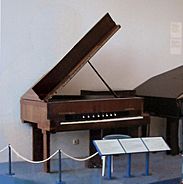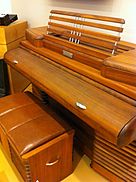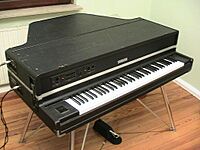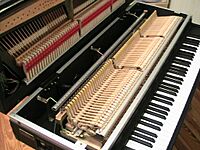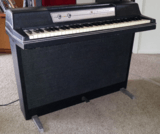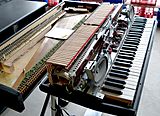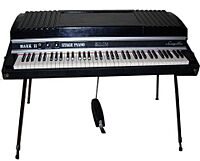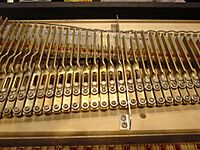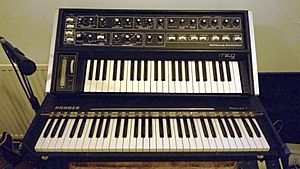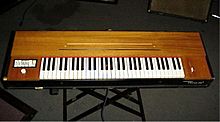Electric piano facts for kids
A electric piano is a piano that makes sounds using mechanical parts and electricity. Unlike a regular piano, it doesn't have a large wooden soundboard. Instead, it uses special pickups to turn the vibrations into electrical signals, which are then sent to an amplifier and speakers. This means electric pianos can be much smaller and louder!
Contents
History of Electric Pianos
The first electric pianos appeared a long time ago. The Neo-Bechstein electric piano was built in 1929. Then came the Vierling-Förster electric piano in 1937.
A very important early electric piano was the RCA Storytone, built in 1939. It was a team effort between Story & Clark and RCA. The famous designer John Vassos created its cool look. This piano was special because it had normal strings and hammers, but no soundboard. Instead, it used electromagnetic pickups and speakers to make the sound louder. This made it the first electric piano sold to the public!
Many early electric pianos were made to be cheaper than regular acoustic pianos. They were popular for homes and schools. Some even had multiple keyboards, so teachers could teach many students at once using headphones.
Different Kinds of Electric Pianos
The term "electric piano" actually covers several different types of instruments. They all make sound in unique ways, which gives them different musical sounds.
Pianos with Struck Strings
Some electric pianos, like those from Yamaha, Baldwin, Helpinstill, and Kawai, are very similar to regular pianos. They have real strings and hammers. Helpinstill pianos even have a traditional soundboard. Others, like Yamaha's, don't have a soundboard. They are more like an electric guitar in how they work.
These pianos use special pickups to turn the string vibrations into electrical signals. Yamaha, Baldwin, and Kawai use piezoelectric pickups under the bridge. Helpinstill instruments use electromagnetic pickups attached to the frame. All these pianos sound a lot like an acoustic piano.
Pianos with Struck Reeds
Wurlitzer electric pianos, often called "Wurlis," use flat steel reeds. These reeds are hit by felt hammers. The reeds and a metal plate work together as an electrostatic pickup system. This system creates a very special sound. It's sweet and like a vibraphone when played softly. When played harder, it gets a hollow, resonant sound.
To tune a Wurlitzer, you add or remove a small amount of solder from the end of each reed. Other pianos like the Columbia Elepian and the Hohner Electra-Piano use a similar reed system. However, they use electromagnetic pickups, like the Rhodes piano.
Pianos with Struck Tuning-Forks
The Fender Rhodes uses a unique system that looks like a tuning fork. One part is a stiff steel wire called a "tine." The other part is a "tonebar," a strong steel bar that helps the sound last longer. A small spring on the tine helps with fine-tuning the pitch.
A hammer with a neoprene tip hits the tine. Each tine has an electromagnetic pickup nearby. The Rhodes piano has a distinct bell-like sound. It's fuller than a Wurlitzer and has a longer sustain. When played hard, it can even make a "growl" sound.
Pianos with Plucked Reeds
Hohner's original Pianet uses special sticky pads made of leather. These pads are soaked in silicone oil. When a key is pressed, the pad sticks to and plucks a metal reed. When the key is released, the pad also acts as a damper. It uses an electrostatic pickup system, similar to the Wurlitzer.
The Pianet's sound is like a Wurlitzer but brighter and doesn't last as long. This is because it doesn't have a sustain pedal. Hohner's "Cembalet" is similar but uses rubber pluckers. Later Pianet models, like the "Pianet T," use silicone rubber suction pads and electromagnetic pickups. The Pianet T has a softer sound, much like a Rhodes.
The "Weltmeister Claviset" is a close copy of the Cembalet. It has electromagnetic pickups and a battery-powered preamplifier. Later models even have different sound filters and a sustain pedal.
Other Electric Keyboard Instruments
While not technically pianos, some other electric instruments are worth mentioning. These include electric harpsichords and clavichords.
Baldwin made a "Solid-Body Electric Harpsichord." It had an aluminum frame and no soundboard. It used two sets of electromagnetic pickups. This instrument sounded a bit like an electric guitar. It was sometimes used in modern chamber music as a substitute for a guitar.
Hohner's "Clavinet" is like an electric clavichord. When you press a key, a rubber pad pushes the string onto a metal "anvil." This makes part of the string vibrate. When you let go of the key, the string is quickly silenced by yarn. Two electromagnetic pickups, one above and one below the strings, pick up the vibrations. These signals are then amplified, often by a guitar amp.
Playing Electric Pianos
Electric pianos sound quite different from acoustic pianos. This difference has given them their own unique place in music. Electric pianos are amplified through keyboard amplifiers. This means they can be very loud, which is perfect for big concerts.
Since they are electric, you can also add cool electronic effects to change their sound. Things like distortion, phasers, or reverb can make an electric piano sound totally different.
For example, the Rhodes piano is great for playing long, smooth chords. This would be hard to do on an acoustic piano. The Hohner Clavinet, especially with effects, is known for its percussive, funky sounds. These sounds are more like funk rhythm guitar or slap bass than traditional piano playing.
Early Wurlitzer models used vacuum tube amplifiers. These could be "overdriven" to create a special kind of distortion. Later models used transistors and had a soulful tremolo effect instead.
Images for kids
See also
 In Spanish: Piano eléctrico para niños
In Spanish: Piano eléctrico para niños



